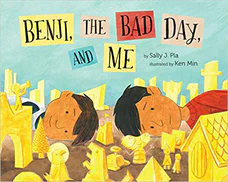Benji, the Bad Day, and Me

Recommended Age Range: Kindergarten through 4th grade.
Publisher's Summary:
Nothing seems to be going right for Sammy today. At school, he got in trouble for kicking a fence, then the cafeteria ran out of pizza for lunch. After he walks home in the pouring rain, he finds his autistic little brother Benji is having a bad day too. On days like this, Benji has a special play-box where he goes to feel cozy and safe. Sammy doesn’t have a special place, and he’s convinced no one cares how he feels or even notices him. But somebody is noticing, and may just have an idea on how to help Sammy feel better.

Dr. Annie's Takeaways
Recommended for: This book is a very sweet, heart-warming read for a non-autistic child with an autistic sibling. The book validates the challenges of having an autistic (or otherwise neurodiverse, disabled, etc.) sibling while showing the depth and importance of the siblings’ love for one another. This book is probably best for children who are both able to recognize each other’s feelings to some extent and to engage in reciprocal affection and/or caretaking behaviors.
Would a child like it? Many children who have an autistic sibling will feel validated by Sammy’s expressed frustrations. The ending is extremely sweet but may actually be more appealing to parents than to children, depending on how realistic it is for a particular family.
Tone: Validating, heart-warming
Story Quality: This story manages to simultaneously validate a non-autistic sibling’s frustrations with the attention and considerations an autistic sibling gets while also telling a story about the love between an autistic sibling and his non-autistic brother. It flips a cliched script by showing the autistic sibling taking care of his non-autistic brother.
Illustrations: Attractive, emotionally evocative illustrations (maybe in watercolor and collage?).
Representation: Sammy, his younger brother Benji, and their mother have light brown skin and straight, black hair. Sammy appears to be a non-autistic boy, and he has a younger brother, Benji, who is not identified as being autistic but who has characteristics that suggest this diagnosis. Benji has a box that is his safe space; he speaks in a limited, scripted manner; he goes to a therapist who engages him in games and activities (hilariously described as the “Super-Happy Lady”); and he likes being wrapped tightly in a blanket on stressful days. The author, Sally J. Pla has three boys, including an autistic son, who reportedly influenced this story.
Psychological Practices: This story does two things: it validates the challenges of having an autistic sibling (in this story, not being able to take karate lessons due to the family needing to attend Benji’s therapy sessions, Benji not responding to Sammy asking him to join him in an activity, their mother seeming to notice Benji’s projects more than Sammy’s, Benji having a special box to hide in that Sammy doesn’t have), and it shows how, despite these challenges, siblings can have a loving relationship and both take care of one another. The story begins by validating Sammy’s frustrations. He’s had a bad day, and no one at home is comforting him, or even seeming to pay attention to him. He compares his experience to how his brother gets special care and attention when his brother has had a bad day, and Sammy cries “mad-sad shivery tears.” Many children with autistic siblings will relate to Sammy’s feelings and experiences, and the story presents a great moment to ask a child if they ever feel the way Sammy does. Through a two-page illustration, the story shows the reader that Benji is, in fact, noticing Sammy’s feelings. Benji pulls Sammy over to his blanket and comforts him the way that their mother comforts Benji–by wrapping Sammy in a blanket and saying, “You’re my little burrito.” The two boys then snuggle and their mom joins in. The message is that the boys’ relationship isn’t one-sided. Sammy makes sacrifices to help take care of his brother, and Benji cares how Sammy is feeling and can help take care of him too. This is obviously extremely sweet, and I love how it flips the caretaking script, but I do have a few concerns, which I’ll describe below.
Concerns: The ending of the story is really adorable, and I love how it challenges assumptions about an autistic child’s caretaking capacities, but for many families it may be unrealistic and could set a child up for disappointment if their sibling doesn’t behave similarly. Many young, autistic children do not engage in caretaking behaviors as overtly and effectively as Benji does, and I would not want a non-autistic sibling to assume that their autistic sibling doesn’t actually care about them if their sibling doesn’t respond comparably. This book is probably best for siblings who are both able to identify another’s feelings to some extent and to provide comfort to each other. Otherwise, the adult reading the book will likely want to clarify or point out other ways that an autistic sibling shows that they care about and love their non-autistic sibling.
